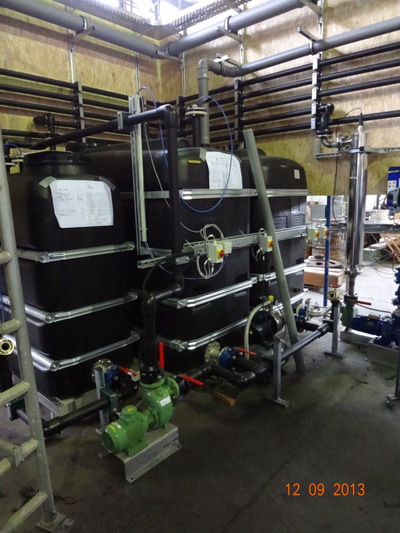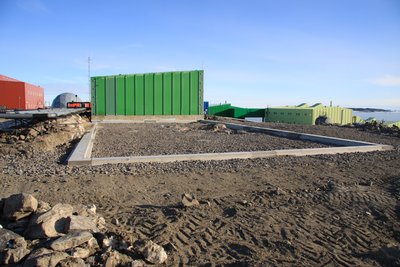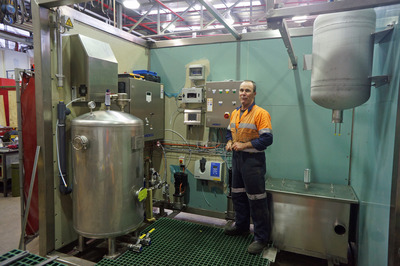Grand wastewater designs
Friday, 31 January, 2014
A state-of-the-art wastewater treatment system, planned for Antarctica’s Davis station, will convert effluent into some of the cleanest water in the world. This effluent will have minimal impact on the marine environment when it’s discharged to the ocean.
Since 2005, when Davis station’s original secondary treatment plant failed, effluent has been macerated and discharged to the ocean from a pipe at the water’s edge near the station’s wharf. While this disposal method meets the minimum requirements specified in the Madrid Protocol and the Antarctic Treaty (Environmental Protection) Act 1980, an environmental impact assessment, conducted by Antarctic Division scientists in 2009-10, identified a need for enhanced secondary or tertiary sewage treatment.
“The environmental impact assessment showed that while the effluent was reasonably dispersed during the period of our study, it was not dispersed rapidly enough to prevent accumulation of some contaminants in the environment, and related adverse impacts,” says assessment leader and marine biologist Dr Jonny Stark.

To address these issues, the Australian Antarctic Division established a project, led by engineer Michael Packer, to install both secondary and advanced wastewater treatment systems. The first step was a request for tender for construction of a secondary sewage treatment plant that would meet Antarctic-specific requirements.
“The problem with sewage treatment in Antarctica is that there are significant technological requirements to process the water to a high level, but limited available knowledge to run the plants at the stations,” Packer says.
“When we prepared our specifications for tender, we picked components and processes that have a long history of operation in rugged conditions, that are simple to operate and that have low maintenance needs. We then put them together in a novel fashion that balanced maintenance, reliability and state-of-the-art features.”
They found part of their answer in German company Martin Membrane Systems, which has successfully provided secondary treatment plants for the German and Norwegian Antarctic programs.
Over the next three years, the company will deliver secondary treatment plants to Davis, as well as Casey and Mawson, whose plants have reached their expected life span.


One of the Antarctic-specific operational requirements for the secondary treatment plants was that they accommodate large flows in summer, for up to 150 people, and significantly smaller flows in winter. To achieve this, Martin Membrane Systems designed the plants so that one of the tanks in the three-tank system can be switched off over winter.
The secondary plants will use a standard biological nutrient reduction process, where the effluent is digested by microbes in aerobic (oxygenated) and anaerobic (no oxygen) processes, before being filtered to remove the solids and microbes. A centrifuge will then reduce the solids to a cake for return to Australia.
Because the Madrid Protocol prohibits the introduction of non-native organisms into Antarctica, microbes from Casey’s and Mawson’s existing plants will seed the new systems. As Davis has no existing plant, effluent direct from the kitchen, bathrooms and other sources will provide the seed culture for the system. This will extend the start-up time of the Davis system by about six months, as a healthy population of microbes becomes established.
The secondary treatment plants will also be able to process kitchen waste, improving the effluent quality before it enters the system. While the processing of multiple waste streams through treatment plants is quite common in Australia, it hasn’t been attempted in Antarctica on this scale.
“Our Antarctic wastewater is very concentrated as there’s no external addition of water, such as rainwater,” Michael says.
“So the plants have a high biological load, which affects the biochemistry to the point that there may not be enough carbon relative to the amount of nitrogen. Kitchen scraps will help rebalance this equation and improve the effectiveness of the plants. It also means we won’t have to incinerate the kitchen waste anymore.
“At the end of the secondary treatment, we expect to get good quality effluent by world standards. We’ll improve on that further with the advanced treatment plant at Davis, so that we can address the issues that arose out of that station’s environmental assessment.”

The advanced treatment plant is being built at the Australian Antarctic Division, with funding, research, design and testing input from academia and industry partners, including the Australian Water Recycling Centre of Excellence, Victoria University, the University of Melbourne, Veolia Water, TasWater and AECOM.
The advanced treatment plant will employ an arsenal of germ-killing technologies to achieve an astounding 13 ‘log reduction’ in pathogens. A one log reduction kills 90% of pathogens; a two log reduction kills 99%; and so on to 11 decimal places. The average log reduction from a freshwater treatment plant in Australia is four to five.
To achieve this kill rate, the treated effluent will undergo ozone disinfection, ultrafiltration, passage through a biologically activated carbon filter, reverse osmosis, ultraviolet disinfection and chlorination.
The result will be some of the cleanest water in the world. In fact, it will be so low in salt it will corrode metal pipes, so lime will have to be added to replace the salts and ions characteristic of normal tap water.
While there are no immediate plans to use the purified water for drinking, the project partners are researching the level of processing needed to achieve potable re-use using their methods, based on Australian Drinking Water Guidelines and World Health Organization guidelines.

Once built, the advanced treatment plant will fit inside two shipping containers. This will include space for a laboratory for regular water quality testing. The plant will then undergo extensive testing by academic and industry partners at an urban water site.
“The plant will be run for two years to iron out any problems and give our academic partners an opportunity to conduct a range of research and improvement projects, some of which will continue in Antarctica,” Michael says.
Once in Antarctica, the advanced treatment plant will be removed from the shipping containers and installed in a purpose-designed building alongside the secondary treatment plant. The combination of the two treatment plants will provide an exciting new chapter in wastewater treatment.
“This project is an opportunity to develop a secondary-level wastewater treatment plant that has application far beyond Antarctica,” Packer says.
“A wastewater treatment plant of this size and capacity would potentially find applications in a wide range of remote communities. When coupled to the advanced treatment plant, it will offer a complete, self-contained, small-scale solution to produce purified recycled water for drinking or non-drinking purposes.”
Gippsland Water eliminates pump blockages at Morwell WWTP
At its Morwell Waste Water Treatment Plant, Gippsland Water has used two Gorman Rupp Ultra V...
Meat rendering company employs Gorman-Rupp pumps
Bush's Proteins has been using Gorman-Rupp Super T Series self-priming wastewater pumps for...
Synthetic dyes in wastewater pose threat to ecosystem
A study has found that dyes commonly used in textiles, food and pharmaceuticals can pose a threat...











